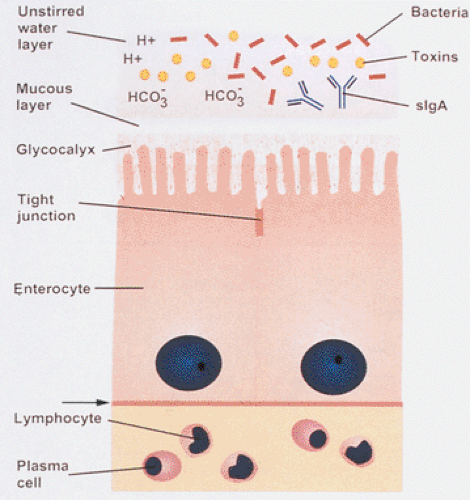Small Intestinal Mucosal Barrier
The mucosal surfaces are regions where individuals and the environment meet. The gut mucosa is in continuous contact with food antigens, the enteric commensal bacteria that constitute the normal gut flora, and potential pathogens that enter the host through the intestine. The upper intestinal bacterial count is normally low and it increases as one progresses distally. Bacterial numbers are kept low by intestinal motility, mucus, and the antibacterial effects of pancreatic and biliary juice and gastric acid (Fig. 6.4). This resident microflora maintains a stable environment and eliminates pathogenic organisms by producing antimicrobial substances and short-chain fatty acids. It also stimulates mucosal epithelial growth (19).
The small intestinal mucosa forms a barrier to the unimpeded movement of antigens, pathogens, and other noxious
substances from the exterior world to the internal environment. A single layer of columnar epithelium, held together by tight junctions, lies on an intact basement membrane. Intercellular tight junctions, which are impermeable to large molecules and bacteria, help maintain epithelial integrity and prevent the entry of foreign material. The tight junctions are specialized membrane domains at the apical pole of the cells that not only create a primary barrier to prevent paracellular transport of solutes (barrier function), but also restrict the lateral diffusion of membrane lipids and proteins to maintain cellular polarity (gate function) (20). The tight junction complexes form a complete ring around the apical pole of the cells. Tight junction permeability is plastic and can be altered by extracellular stimuli including bugs and drugs (21). An unstirred layer, which measures 400 to 500 μm in thickness, covers the epithelium. Molecules diffuse into this layer (22).
substances from the exterior world to the internal environment. A single layer of columnar epithelium, held together by tight junctions, lies on an intact basement membrane. Intercellular tight junctions, which are impermeable to large molecules and bacteria, help maintain epithelial integrity and prevent the entry of foreign material. The tight junctions are specialized membrane domains at the apical pole of the cells that not only create a primary barrier to prevent paracellular transport of solutes (barrier function), but also restrict the lateral diffusion of membrane lipids and proteins to maintain cellular polarity (gate function) (20). The tight junction complexes form a complete ring around the apical pole of the cells. Tight junction permeability is plastic and can be altered by extracellular stimuli including bugs and drugs (21). An unstirred layer, which measures 400 to 500 μm in thickness, covers the epithelium. Molecules diffuse into this layer (22).
 FIG. 6.4. Mucosal barrier. The mucosal barrier consists of several nonspecific defenses, including the epithelium, which forms an intact single cell layer. It lies above an intact basement membrane (arrow) and tight junctions seal the upper intercellular spaces. The microvilli are covered by a glycocalyx. Overlying this is a mucous layer followed by the unstirred water layer. The epithelium pumps bicarbonate, water, hydrogen ions, and mucus, as well as secretory immunoglobulin into the unstirred layer above it. These substances interact with bacteria, toxins, or antigens in the lumen. Underlying the epithelium is the lamina propria, which contains abundant immune cells.
Stay updated, free articles. Join our Telegram channel
Full access? Get Clinical Tree
 Get Clinical Tree app for offline access
Get Clinical Tree app for offline access

|





